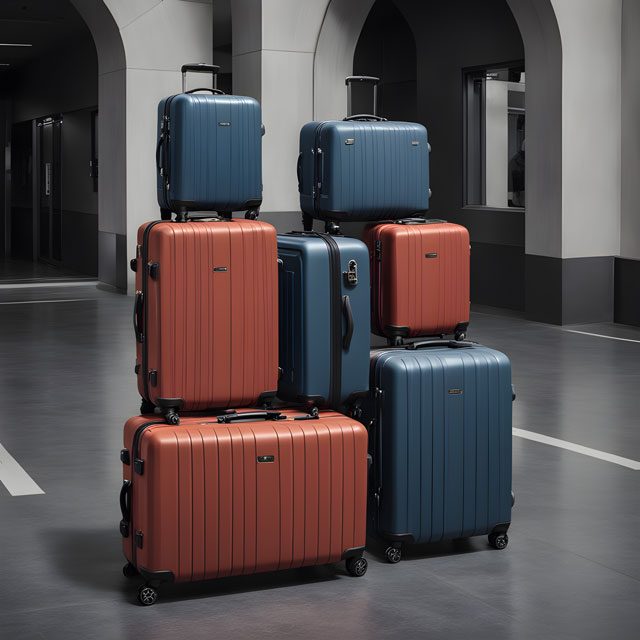
Choosing the right travel bag that suits the type of trip and travel lifestyle is crucial, as selecting a bag that doesn’t match the travel style or meet usage requirements can be a hindrance during the journey. For example, if friends need to carry valuable items in the bag, carry fragile items, or prioritize safety, using a cloth travel bag may not be suitable. Similarly, if traveling long distances and needing to move the bag frequently, opting for a sturdy bag with equipment to facilitate movement is advisable. Choosing a suitable travel bag will not only provide support for friends but also ensure they can enjoy the journey happily.
Size of travel bags
When choosing the size of a travel bag, it’s important to consider how many days the trip will last in order to select a size that is suitable for carrying the necessary belongings. A size of approximately 16-20 inches is suitable for trips lasting 1-3 days. The bag’s size permits carrying it onto the plane without checking it in, but the weight must still meet airline standards. Most airlines typically set a weight limit for bags at around 5-7 kilograms.
Sizes ranging from 24-26 inches are suitable for trips lasting 3-7 days, while sizes of 28-30 inches are suitable for trips lasting 7-10 days. Travelers needing extended trips or lots of items may favor larger sizes, 24-26 inches, possibly requiring check-in.
Materials and Durability of Travel Bags
Travel bags are classified based on the materials used in their construction, typically into two types: Soft Case and Hard Case.Fabric comprises soft case bags, while rigid materials like PC, PP, or ABS construct hard case bags, renowned for durability and heat resistance.
Soft Case bags and Hard Case bags each have their own distinct advantages.
Soft case bags, often of polyester, feature fabric-like appearance, renowned for elasticity, durability, and other desirable properties, popular for travel. Additionally, each model usually includes compartments for organizing belongings, such as document pockets and small item compartments, allowing for easy access without needing to open the entire bag. However, due to the fabric nature of Soft Case bags, stacking or compressing them during travel may risk damaging the contents inside.
Hard case travel bags, also called rigid or hardshell travel bags, feature a box-like appearance, which is familiar and recognizable. The main advantage of Hard Case travel bags is their durability and sturdiness compared to Soft Case bags. Materials like PC (Polycarbonate), PP (Polypropylene), or ABS (Acrylonitrile Butadiene Styrene), known for high elasticity, strength, heat resistance, and lightweight properties, typically constitute them.These materials help maintain the shape of the bag and protect the contents inside, making them commonly used in the production of Hard Case bags to reduce damage during travel.
Manufacturers often design Hard Case bags with combination locks to enhance security against unauthorized access.However, one consideration is that they may not have external compartments for easy access to items. If you need to access items inside the bag, you may need to open the entire bag. Additionally, Hard Case bags tend to be relatively expensive.
Wheel system of travel bags
Wheels are another crucial component for travel bags as they provide assistance in moving the bag. Typically, there are two types of wheel systems in the market: 2-wheel and 4-wheel. The advantage of the 2-wheel system is that when we place the bag in a fixed position, such as when boarding a bus or a train, the bag will not roll away because it has only two wheels, and the other two sides act as brakes or stabilizers for the bag automatically.
On the other hand, the advantage of the 4-wheel system is that it assists in moving or dragging the luggage when walking. If you have to travel long distances or walk for extended periods, using a bag with a 4-wheel system helps save energy and reduces arm and shoulder pain. However, bags with a 4-wheel system typically offer fewer features to prevent wheel rolling or locking, requiring caution on inclined surfaces or during multi-modal travel. Another consideration is to choose a 4-wheel system with dual-spinner wheels that can rotate 360 degrees, as they are more durable and provide greater maneuverability in limited spaces.
Luggage lock system
Designers craft travel bags for opening, typically categorizing them into two types: zippered and lockable. Zippered bags offer the convenience of easy access, making it simple to open and close the bag when packing and unpacking belongings. However, security considerations arise with zippered bags due to their susceptibility to tampering. Yet, newer models incorporate dual-layer zippers, strengthening bag security.
On the other hand, lockable bags offer greater security as they are more difficult to tamper with. Lockable bags enhance the safety of belongings, with the locking mechanism acting as a deterrent to unauthorized access. The lock system provides a convenient means to secure the bag for frequent use, without being much more complex than using a zippered travel bag.

Handle/Strap and Pulling System of Luggage
The luggage pull handle must be sturdy, securely attached to the bag, and resistant to shaking or lifting. It’s essential to choose a handle with stability and strength. For a reliable luggage pull handle, opt for a dual-bar design that’s tight and robust for heavier loads.The luggage pull handle typically has a frame attached to the back of the bag, allowing for easy gripping without shaking or lifting during use. However, for those who don’t carry heavy loads, prioritizing convenience and lightweight options, a single-bar luggage pull handle can suffice.
When it comes to bag straps, it’s crucial to ensure they are thick and robust, capable of securely holding onto the bag. They should bear the weight of the bag and its contents, particularly when lifting or carrying it up and down stairs during travel. Bag straps with top and side attachments ease lifting, enhancing convenience and usability, ideal for travel.Additionally, when it’s necessary to stow the bag under a vehicle or in an overhead compartment, having multiple points of attachment helps transportation personnel move the travel bag more conveniently, reducing the risk of damage to the luggage.
Luggage Lock System
Choosing luggage in today’s era solely based on aesthetics, design, or convenience might not suffice, as safety is also crucial. The TSA (Transportation Security Administration) lock system enhances luggage security for travelers with its code-lock design. It prevents unauthorized access or tampering with the luggage. The special feature of TSA locks helps mitigate damage in cases where transportation authorities need to open luggage for inspection. If authorities discover suspicious items, they can promptly unlock the luggage with a special key. If using other types of locks, authorities may resort to damaging the lock for inspection. In such cases, TSA locks help minimize potential damage to the luggage.
Each trip has different travel objectives, whether it’s for leisure, business, returning home for rest, shopping, or international travel. Hence, luggage becomes an indispensable and crucial item. Choosing travel luggage isn’t just about carrying gear but also reflects style, boosting confidence for pleasant travel experiences.
Read other travel articles here.






